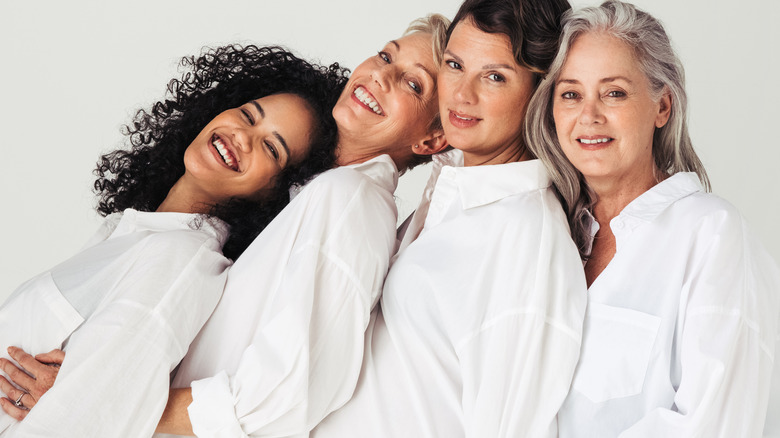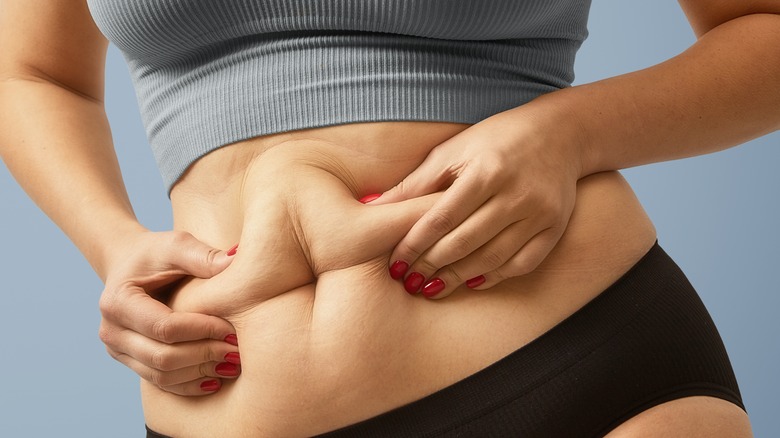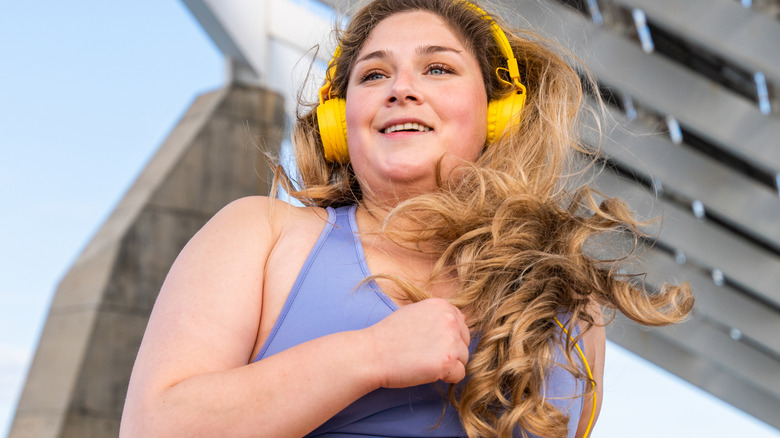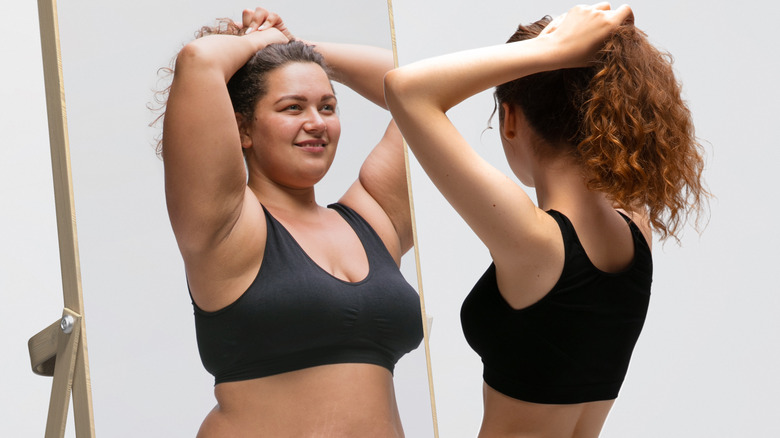Body Positivity Vs. Fat Liberation: The Real Difference (& Why Both Matter)
Thanks to pop culture, fashion, and social media, we are continually exposed to unrealistic beauty standards and unhealthy comparisons that distort our definition of true beauty and take a toll on our body image. And that's part of the reason why the body positivity movement was birthed — due to heightened awareness of the consequences of weight discrimination and fat shaming, per a 2018 review published in Current Obesity Reports.
The goal of the movement is to fight appearance stereotypes and empower people to cherish the skin they wear, regardless of their size, shape, skin tone, or other physical characteristics that are deemed unattractive by society. The influence of the movement is such that many fashion brands are switching from designing clothes for stick figures to introducing plus sizes, in an attempt to champion body positivity and win more customers. Cue new ads from Victoria's Secret, ModCloth, and Aerie.
But while body positivity is a noble and uplifting cause, it's gotten increasingly confusing in recent years. Today, it's often confused with "fat liberation:" a social movement that seeks to liberate obese people from the stigma and oppression toward overweight individuals by raising awareness among the general public. These terms are often used interchangeably, and from the outside, they might seem to describe the same thing. But the two movements carry profoundly different meanings. Here's the real difference between body positivity and fat liberation — and why both matter.
The story of body positivity
The beginnings of the body positivity movement can be traced back to the fat acceptance movement of the 1960s (the same era civil rights movements were intensifying), according to the Waterloo-Wellington Eating Disorders Coalition. Back then, women and people of color were often portrayed in popular culture and public discourse as overweight and lazy, which is why the movement addressed fatphobia as a result of sexism and racism. In 1969, the National Association to Advance Fat Acceptance (NAAFA) was first established, and has since continued to work to fight size-based stereotypes and discrimination.
"Body positivity means I am free," said Connie Sobczak, who co-founded the self-acceptance-focused community The Body Positive in 1996 — over a decade before the revival of the body positivity movement (hashtag #BoPo) enjoyed a brand new boom on social media (via USA Today). In the 2010s, body positivity took on new interpretations and was no longer restricted to mere sizing.
"Back [in 2010], the term 'body positivity' was interchangeable with the fat acceptance tag, as many larger fat plus-size people were using both hashtags at the same time," plus-size blogger Stephanie Yeboah tells Vice. "Back then, it felt like a safe space for larger fat Black women and women of colour to celebrate our bodies, and speak about our traumas surrounding fatphobia and society policing our bodies. The movement in 2011 and 2012 was incredibly diverse, featuring an array of different shaped bodies, sexualities, identities, abilities and races. It felt safe."
What to know about fat liberation
Body positivity is often mistaken with fat liberation because it has roots in the fat acceptance movement. Fat acceptance activists who fight for fair treatment of people of size in healthcare, fashion, and employment are commonly referred to as champions of "fat liberation" or "fat rights," Verywell Mind points out. "Fat people exist within every marginalized identity; NAAFA is uniquely positioned to work toward liberation for all," writes NAAFA on its website.
Per an article published in the Canadian Medical Association Journal, people have a way of racializing obesity, and those with obesity are often seen as marginalized groups, even in a clinical setting. Few of us are immune to numerous embedded presumptions about fatness, considering we live in a society that glorifies shining examples of weight loss and body image restoration. To overcome the weight-based stigma, we need more than a set of do's and don'ts.
Like other people, those who are considered overweight also deserve compassion and care — not derogatory humor or body-shaming scoffing. According to researchers, the onus is on the people in the medical field to treat obese patients with respect. Research has shown that healthcare providers spend less time with obese patients. According to a study published in the International Journal of Obesity, polling 122 physicians, healthcare providers reportedly spent less time with patients who were overweight or obese although they prescribed these patients more tests.
Body positivity vs. fat acceptance
The major difference between body positivity and fat liberation is that body positivity is no longer confined to the matter of sizing or body mass, which remains the central theme of fat liberation.
The body positivity movement strives to empower people to cherish and find worth in bodily traits that are not necessarily linked to fatness, such as stretch marks, skin tone, height, and even issues of being underweight. "Body positivity has really become a movement for thin women who have belly rolls when bending over," says dietician Shana Spence (via Healthline). "It's a far cry from the movement that fat Black women started which was about bringing to light actual weight stigma and discrimination that those in larger bodies face."
In other words, body positivity is not so much about being fat or thin as it is about inclusion and self-love. On the other hand, battling weight bias has been at the heart of the philosophy, action, and radicalism of fat liberation since its inception. Body positivity might encapsulate fat liberation, but fat liberation is not adequately representative of body positivity.
If body positivity is about changing one's own mindset, fat liberation is focused on altering the general public's opinions about fat people. It's up to each person to decide which is harder — changing our own views or changing the views of others. But what we know is that the fight for justice and equality for fat people is still a work in progress.
Why body positivity is falling out of favor
Body positivity is a great cause, but it's getting increasingly fragmented and deviating from its original purpose — to advocate for the most marginalized people in the fat community — like those who identify as Black, gender-fluid, or are differently abled.
Today, body positivity is all about being content and confident in your body, like the "Fashionistas" range of large-bodied Barbie dolls and plus-sized Victoria Secret's models. Even skinny girls can hop on the bandwagon and claim that "body positivity" is not "fat positivity" and anyone with a body deserves representation in this movement.
Truth be told, sweeping inclusion wasn't exactly what the founding fathers of fat liberation had in mind when they started the movement. This expansion of the concept defeats its intended purposes and does little to raise awareness about the discrimination burden that fat people with a marginalized identity face in their day-to-day lives. The generalization of body positivity causes people to look at obesity as a single thread in a multi-colored tapestry — not really an issue that needs more zeroing in and addressing in public discourse. If anything, this idea of body positivity has benefited only the beauty industry and its influencers.
Why fat liberation matters
Overweight people encounter discrimination in many different forms. But it's is hard to prove, and there are not many laws that protect overweight employees, per Sterling Employment Law.
In 1993, advocates of the fat liberation movement experienced a major victory when a 5-foot-2-inch, 320-pound Rhode Island woman, Bonnie Cook, successfully sued the Ladd Center for treating her unfairly throughout the recruiting process due to her weight, per Justia. On the other hand, in 2019, bus driver Corey Dickson (who weighed over 500 pounds) sued his company for allegedly firing him because of his weight. The court, who said weight was not a protected class, dismissed his claim, per Justia.
The fashion world is also accused of failing fat people. Per Plunkett Research, 68% of women in the U.S. are believed to be size 14 or larger as of 2018. Yet a survey by NPD revealed that only 18% of the clothes sold in 2016 catered to plus-size-identifying customers (via CNBC). "I've been a plus size woman all my life. And some of the most formative memories for me were on the shopping floor and how painful it really is to shop above a certain size," said Nadia Boujarway, Dia&Co's CEO and co-founder.
Epidemiologist Adam Drewnowski tells USA Today that obesity is not a choice. It's more prevalent in areas with insufficient medical and financial resources, which ultimately results in a vicious cycle of poor health. "I call it a visible symptom of economic oppression," says Drewnowski.
The potential downsides of fat liberation
While some might find the fat liberation movement helpful, others have raised questions about whether the movement is glorifying obesity. Journalist Lizzie Cernik — an opponent of the fat acceptance movement — writes in her column in The Guardian, "Fronted by plus-sized models and social media influencers, the fat acceptance movement aims to normalise obesity, letting everyone know that it's fine to be fat."
Pointing out that some influential figures are equating health officials' concerns about obesity to hate crimes, Cernik stresses that health campaigns are not intended to boost people's egos, but rather to spread the word about potential health hazards. You can agree or disagree with Cernik's point of view, but there's no denying she has a valid point.
While people who are overweight undoubtedly face discrimination, there is also substantial evidence that weight gain carries health risks. "Obesity is tied to chronic conditions like diabetes, heart disease and some cancers," says physician Dr. Sharon D. Allison-Ottey (via Good Housekeeping). Regardless of your weight or your views on fat acceptance, you can stay healthy. Some simple lifestyle habits, such as eating nutritiously, managing stress, and staying physically active, are helpful in keeping you in tip-top shape.






